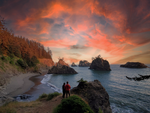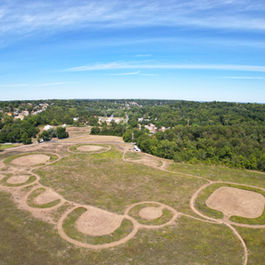The Peter Iredale, a four-masted steel barque constructed in Maryport, England, in 1890, belonged to a large fleet of ships owned by the British shipping company Iredale & Porter.

Following eight successful voyages to the west coast, she departed Salina Cruz, Mexico, on September 26, 1906, en route to Astoria, Oregon to load wheat destined for the United Kingdom. Despite navigating through thick fog, the ship safely approached the mouth of the Columbia River in the early hours of October 25. At the mouth of the river lay the Columbia Bar, a system of sand bars and shoals, renowned globally for its treacherous nature, ranking among the most dangerous bar crossings in the world. Captain H. Lawrence of the Iredale was well-acquainted with its perils, having navigated it numerous times and being mindful of its role in the wreck of the Iredale's sister ship, the Cairnsmore, in 1883. While waiting for a pilot to guide the Iredale through the channel, a fierce southeast gale blew and a strong current led the ship ashore, grounding her at Clatsop Spit.
An article, published by the Morning Astorian on October 26, 1906, described the event.

Captain H. Lawrence described the event, stating, "a heavy southeast wind blew and a strong current prevailed. Before the vessel could be veered around, she was in the breakers and all efforts to keep her off were unavailing."

The Iredale grounded on Clatsop Beach with such force that its three masts snapped upon impact. Fortunately, none of the crew sustained serious injuries.
As Captain Lawrence ordered the abandonment of the ship, rescue crews from Point Adams arrived on scene and safely brought all twenty-seven crew members, including two stowaways, to shore. As the situation developed, locals from the vicinity flocked to the scene, liquor bottles in hand, to assist the crew and offer a drink. William K. Inman, one of the rescuers aiding Captain Lawrence, recalled the poignant moment when the red-bearded captain, standing tall, saluted his vessel and uttered, “May God bless you and may your bones bleach in these sands.” Turning to his men with a bottle of whisky in hand, he invited, “Boys, have a drink.”
According to The Morning Astorian, some members of the Iredale's crew indulged a bit too much in the hospitality, offering: "...nearly all were equipped with big, or little, bottles of liquor, which under certain circumstances may have done a certain amount of good, but which, in the instance under consideration, was altogether too generously applied and to the ultimate discomfiture of several of the Iredale's crew, who were too drunk to make good with the rest of their fellows in reaching this city."
After the safe evacuation from the Iredale, a group of volunteers from nearby Fort Stevens, led by Colonel Leverett H. Walker, promptly arrived to assist the crew. Within an hour, the crew, cold, wet, hungry, reached Fort Stevens, where they were fed and clothed as they awaited further instructions.
After the crew were tended to, Colonel Walker dispatched a team of mules to assist the rescue crew at Point Adams in pulling the boat across the beach to a suitable launching point for repairs.
In the afternoon, Colonel Walker was contacted by British Consul P.L. Cherry, who asked him to send the crew of the Iredale to Astoria via train. The consulate covered the expenses, and soon after departing from Fort Stevens, the crew, minus three that remained at Fort Stevens and four that stayed with the Iredale, arrived in Astoria.
The photo below, captured by a local Portland photographer, shows the Iredale shortly after its grounding.

As culpability loomed, British Consul James Laidlaw targeted Captain Lawrence and Chief Officer Langmaid, alleging their irresponsible actions of approaching dangerously close to shore. The Tacoma Daily Ledger documented Laidlaw's assertions on November 1, 1906.

The British Vice-Consulate conducted a Naval Court inquiry in Astoria on November 12 and 13, 1906, to ascertain the cause of the wreck. Following a thorough investigation, no fault was attributed to Lawrence and his crew regarding the loss. Instead, Lawrence and his officers were praised for their commendable efforts in trying to salvage the ship. Portland's The Province was first to report the court's findings in an article circulated on November 14, 1906.

Despite minimal damage to the ship's hull, efforts were initiated to tow it back to sea. However, after several weeks of waiting for conducive weather and ocean conditions, the vessel became firmly entrenched in the sands. Consequently, the Iredale was listed for auction. A notice, circulated by the Morning Astorian on November 29, 1906, outlined the asking price set by its owners, P. Iredale & Porter.

With no takers, the ship lay grounded at Clatsop Spit, quickly becoming a hit with tourists.

In the ensuing decades, the Iredale gradually yielded to the forces of nature, with waves, wind, and sand inexorably wearing her down. Enthusiastic tourists sought relics of maritime history along Clatsop Beach, while larger remnants of the ship were swept away by the sea.

Today, only fragments endure from the once grand vessel. Enduring a century of relentless battering from the Pacific, the Peter Iredale has been relegated to a rusted bow and scant remnants of its once towering masts. Despite its diminished state, it stands as one of the most accessible shipwrecks along the West Coast.

Located within Fort Stevens State Park, the remnants of the ship are very easy to reach. Simply follow Peter Iredale Road in Fort Stevens State Park until you reach the parking area at the beach. From there, it's a short stroll of a hundred or so yards along the beach to the north. It's also listed as a waypoint on Google Maps.
On a road trip with my dad a few years back, we explored the Iredale at low tide, which appeared to be the best time for a visit.

For fellow history dorks, exploring more within Fort Stevens State Park might pique your interest. Among the notable sites are Battery Russell, Battery 245, Battery Mishler, Battery Clark, and Battery Pratt, each offering unique historical insights. However, if time allows for only one visit, I highly recommend Battery Russell. This two-level reinforced concrete battery played a vital role in defending the Oregon Coast during WWII. Its features include munitions rooms, offices, guard rooms, storage areas, and a gun pit where two immense ten-inch retractable guns were once stationed.

Battery Russell and Fort Stevens hold the unfortunate distinction of being the first mainland American site to face enemy shelling since the War of 1812. In June 1942, a Japanese Navy submarine unleashed seventeen shells from a distance of ten miles off the coast, with nine landing near Fort Stevens. Months later, a small foldable water plane piloted by Nobuo Fujita dropped two incendiary bombs on the coast from a submarine, marking the first and only instance of mainland America being bombed by a foreign adversary in American history.
Down the Trestle Bay Trail, about a mile from the visitor center, stands the Observation Pillbox, another significant military structure erected in 1942 during WWII as part of the coastal defense system. The pillbox served as an observation post, enabling monitoring of the ocean and surveillance for any suspicious activities, including enemy ships and submarines.

Other interesting sites to explore at Fort Stevens include the Jetty Observation Tower and Military Museum. Fort Clatsop, where Lewis and Clark sojourned during their renowned expedition winter of 1805-1806, lies only fifteen minutes away. Cannon Beach, celebrated as one of America's most iconic shores, and Crescent Beach are both roughly a twenty-minute drive south from Fort Stevens.
If you're interested in more great spots to visit in western Oregon, consider reading Eight Days in Oregon: Waterfalls & Redwoods or 12 Most Beautiful Waterfalls in Oregon.
_edited.png)









































Comments